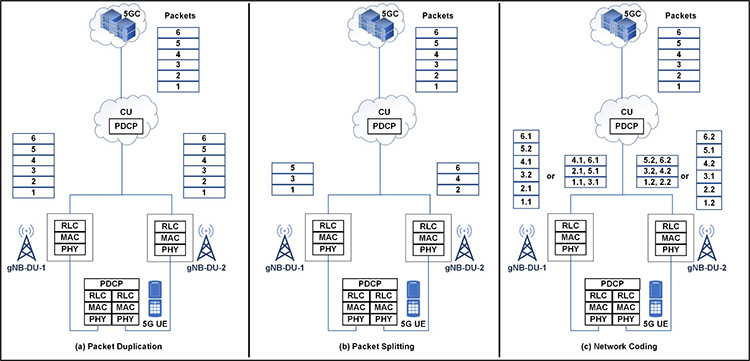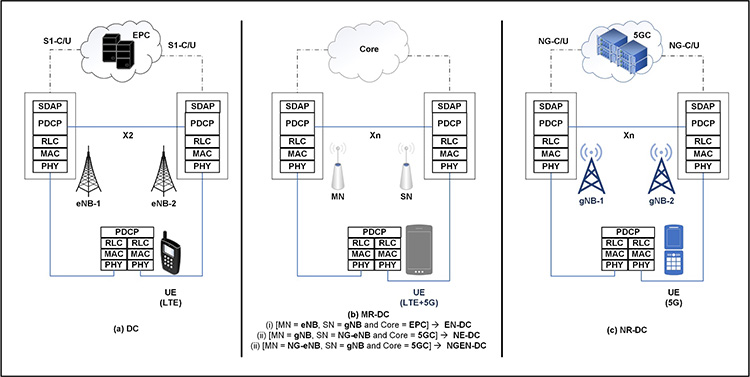Abstract
Multi-connectivity (MC) is a key enabler for 5G networks and beyond. It enhances the network performance for diverse use cases and across the metrics. With the user simultaneously connected to multiple nodes, MC increases transmission mobility robustness, reduces handover (HO) interruption time and increases the overall reliability of the network. Regarding standardization, MC has evolved from the LTE dual connectivity from 3GPP Release 12 to the 5G new radio (NR) multi-radio dual connectivity (MR-DC) paradigm currently being standardized for Release 16. With the consideration of fronthaul-based architecture and packet duplication features for MR-DC, among others, 5G networks (and beyond) are poised to deliver enhanced quality of service through increased throughput and reliability as well as reduced latency, HO frequency and probability of radio link failures. Further enhancements that aim to address the current challenges of MC operations are already being explored for Release 17 and beyond.
5G New Radio Evolution
Following the release of the first 5G new radio (NR) standard (Release 15 or 5G Phase 1) in mid-2018 by the 3rd generation partnership project (3GPP), several enhancements have been introduced by the cellular standardization body towards the 5G Phase 2 (i.e., the Release 16 which is expected to be finalized by June 2020). These enhancements are expected to further enable the three broad classes of 5G use cases: enhanced mobile broadband (eMBB), ultra-reliable and low-latency communications (URLLC) and massive machine type communications (mMTC).
For 5G NR Release 16, the enhancements are along two directions: (i) upgrading of existing features of previous releases, with respect to areas such as MIMO and beamforming, user equipment (UE) power saving, dynamic spectrum sharing (DSS), carrier aggregation (CA) and dual connectivity (DC)/multi-connectivity (MC), and (ii) enabling of new verticals and deployment scenarios with a particular focus on intelligent transport systems (ITS) and vehicle-to-anything (V2X) communications, positioning, industrial IoT and URLLC features, integrated access and backhaul (IAB) and NR in unlicensed spectrum. These features and scenarios will further enable 5G networks to deliver remarkable improvements across the performance metrics. To further advance the network capabilities, more enhanced features and newer scenarios are under consideration towards Release 17 and beyond [1].
Multi-connectivity Architectures in 5G NR
One of the key features of 5G NR enumerated earlier is multi-connectivity (MC). It refers to the concurrent use of multiple independent communication paths, nodes, access points (APs) or base stations (BSs) for data transmission to a UE. In MC mode, the UE accesses radio resources from multiple nodes that have distinct schedulers. The nodes could be of the same or different radio access technology (RAT) [2], [3]. The MC architecture is a very promising feature for 5G as it has been shown to enable the realization of the stringent constraints (high reliability, low latency and high throughput) for all the broad classes of 5G use cases, from eMBB that targets high-capacity applications (which Release 15 focused on) to the mMTC and URLLC applications which are the primary focus of Release 16. MC also enables ultra high speed and low latency communication (uHSLLC) that represents a mix of the aforementioned use cases.
While the throughput-oriented eMBB targets up to 1 Gbps user-experienced data rates, URLLC applications require 99.999% reliability for 32-byte packet size with 1 ms latency on the user plane (UP). This translates to a packet loss ratio (PLR) or block error rate (BLER) [2]. Industrial, automotive and health care application scenarios (such as industrial automation, autonomous driving, remote surgery, etc) require these stringent requirement to be met and MC is being extensively explored to facilitate delay-sensitive, error-free and/or ultra-fast communication for these applications [2], [4].
According to the 3GPP NR Release 16 standard [5], Multi-Radio Dual Connectivity (MR-DC) is the term that is generally being used for MC. Dual connectivity (DC) refers to the lower bound of MC where the UE is connected to only two APs. In the absence of MC/DC, the UE establishes a connection with only a node at a time (i.e., the legacy single connectivity case). Some of the earlier variants of MC approaches in 3GPP standards include carrier aggregation (CA [Release 10]), coordinated multipoint using joint transmission (CoMP-JT [Release 11]), dual connectivity (DC [Release 12]), LTE-WLAN aggregation (LWA [Release 13]) and MR-DC [Release 15] [2], [6]. The form, aggregation layer and scheduling policy of these MC techniques vary from approach to the other.
Building on the foundations from Release 15, MR-DC in Release 16 is a generalization of different possible configurations of DC where a multiple receive (Rx)/transmit (Tx) capable UE is configured to utilize resources provided by two different nodes connected via non-ideal backhaul, where one node provides NR access and the other provides E-UTRA (Evolved Universal Terrestrial Radio Access), or where both nodes provide NR access. One node acts as the master node (MN) and the other acts as the secondary node (SN). The MN and SN are connected via a network interface and at least the MN is connected to the core network, either the evolved packet core (EPC) or the 5G core (5GC).
In Release 12 (completed March 2015), 3GPP introduced the Intra-E-UTRA Dual Connectivity (or simply DC) which is the inter-site DC between two LTE BSs (i.e., same RAT) where both BSs are connected to the EPC. With the introduction of 5G NR, 3GPP introduced four configurations for MR-DC: one MR-DC with EPC (E-UTRA-NR Dual Connectivity (EN-DC)) and three MR-DC with 5GC configurations (i.e., NR-E-UTRA Dual Connectivity (NE-DC), NG-RAN E-UTRA-NR Dual Connectivity (NGEN-DC) and NR-NR Dual Connectivity (NR-DC)). The first three MR-DC options fall under the non-standalone (NSA) architecture involving two APs of different RATs while the fourth MR-DC option (i.e., NR-DC) represents the 5G equivalent of the LTE DC. These five DC architectures are illustrated in Figure 1. While the Release 12 DC (shown in Figure 1(a)) involves two nodes of the same RAT (i.e., LTE), NR DC involves two NR nodes. It should be noted that Figure 1(b) represents three sub-architectures depending on the different network nodes connected. The newest MR-DC configuration supported by 5G NR is the NR-NR Dual Connectivity (or simply NR-DC) shown in Figure 1(c). Unlike the other DC architectures, the UE in NR-DC is connected to two NR next-generation nodeBs (gNBs). We note that while the EN-DC in Figure 1b (i) is the current priority architecture by operators, NR-DC appears to be the ultimate migration goal for future deployment.
Regarding the NR-DC, two sub-architectures are being explored. The first is the Xn-based NR-DC architecture (illustrated in Figure 1(c)) where the sublayer used for the routing or aggregation (i.e., the PDCP sublayer) is located in each gNB in a distributed fashion. Here, one gNB acts as the MN/MgNB while the other gNB acts as SN/SgNB). The second NR-DC architecture is the fronthaul split-based approach (shown in Figure 2). For the second approach, the PDCP sublayer is located in a centralized unit (CU) in the cloud while all (sub)layers below the PDCP are located in each gNB distributed units (gNB-DUs). One gNB-DU serves as the master cell group (MCG) while the other gNB-DU serves as the secondary cell group (SCG) with both DUs connected to the same gNB-CU [5].

Figure 1: Dual Connectivity architectures (Xn-based framework)
Significance of Multi-connectivity
The principal aim of MC is to exploit the diversity of the simultaneous connection to different communication nodes in meeting the system performance requirements. Using MC, three main types of diversity could be exploited:
- spatial diversity as the case with multiple antenna systems (whether intra-site/co-located or inter-site/distributed/cell-free massive MIMO),
- frequency diversity such as the case with DC over multi-frequency heterogeneous network (e.g., multi-band HetNet involving sub-6 GHz macrocell and millimeter-wave (mmWave)/terahertz (THz) small cells), and
- radio access technology (RAT) diversity where the different RATs involved could be from different standardization bodies (e.g., LTE-WiFi Aggregation (LWA) which was introduced in 3GPP Release 13 and completed in March 2016) or from the same body such as the 3GPP LTE and NR combinations or MR-DC [2].
To enhance 5G networks’ performance (with respect to improved reliability, reduced latency, increased throughput or a combination of these), three approaches have been identified in exploiting the diversity capabilities of MR-DC with respect to packet operations:
- Packet Duplication (PD) where the same packets are sent from the different nodes as illustrated in Figure 2(a). Here, reliability is increased due to the use of multiple redundant links. Also, latency is reduced with the elimination of packet re-transmission and the immediate processing of packets. Overall, PD reduces the frequency of handover, improves mobility robustness and reduces the probability of radio link failure (RLF) as the packets are available at both nodes. However, these gains are at the expense of throughput loss due to increased traffic load.
- Packet Splitting (PS) where different packets are sent over the different paths as shown in Figure 2(b). The PS approach leads to increased throughput as the UE receives packets from multiple nodes. PS also reduces latency if each packet is sent on the faster of the two links. However, PS does not improve reliability as no redundancy is introduced by the approach.
- Network Coding (NC) where different subsets of a packet/combinations of packets are sent on the different paths as shown in Figure 2(c). With subsets, the latency is reduced due to transmission of shorter packets, but the reliability is not increased. With a combination of packets, reliability is increased but the latency may be increased depending on the packet arrival rate and the need for queuing of packets or otherwise.

Figure 2: Packet operations for NR-DC (Fronthaul split-based architecture)
Packet Duplication in NR-DC
The 3GPP has adopted PD for both the control plane (CP) and the UP packets in 5G NR employing DC [5]. As earlier illustrated in Figure 2(a), PD is particularly aimed at meeting the URLLC requirements. Furthermore, a dynamic control option is also introduced where PD can be adaptively activated or deactivated based on the link conditions or network resource availability. When PD is deactivated, the network falls back to single connectivity (usually in conditions where single connectivity is sufficient to satisfy the latency and reliability requirement). The network resumes DC operations when PD is activated.
PD using the conventional Xn-based DC approach would require duplicate data packets to be forwarded from one AP to the other via the Xn interface which can render the system inefficient in the case of high congestion and/or latency. Using the fronthaul split-based approach, however, data is multicast from the centralized PDCP layer to the APs which avoids the Xn interface concerns. In the event of RLF on any of the transmission paths, PD facilitates the re-transmission on the alternate path(s) thereby reducing the overall interruption time and latency [4].
Though only PD has been standardized for 5G NR Release 16 (basically targeting URLLC applications), it may not be suitable for throughput-oriented eMBB or more importantly uHSLLC (i.e., eMBB+URLLC) applications requiring high throughput alongside low latency and high reliability. Therefore, an adaptive framework which dynamically switches from one diversity scheme to the other (PD, PS and NC) is required. In such adaptive networks, PD, PS or NC (for reliability, throughput or latency, respectively) would be activated based on the requirement for performance optimization in future networks. Finally, we note that the DC architecture could be extended to the true MC case with more than two Tx nodes to further exploit the diversity gains in future releases and that several other features and operational enhancements will be introduced in future standards (Release 17 and beyond).
Conclusion
MC enables cellular networks to meet the stringent performance requirement of next-generation applications and use cases. The user in MC mode can access resources from multiple nodes, exploit the diversity of the different nodes and harness gains from features such as packet duplication at the nodes to increase throughput, reduce latency and/or improve reliability. MC also guarantees connectivity to the network during handover thereby facilitating mobility robustness and enhanced overall quality of service. As a result, the MC feature has seen progressive enhancements from 3GPP Release 12 up to the current Release 16 standard. However, despite the significant gains, there are still a number of challenges and open issues for MC operations. These open issues include, among others, the choice of the most beneficial layer for MC operations, need for optimal scheduling policies in multi-cellular multi-user systems using shared spectrum and the need for reduced signaling overhead. These concerns are anticipated to be addressed in future standard releases
Acknowledgments
The research work leading to these results has been by the European Union’s Horizon 2020 Research and Innovation Programme, under the MSCA-RISE Framework (GA-823903-RECENT).
References
- J. Peisa et al., “5G evolution: 3GPP Release 16 & 17 Overview,” Ericsson Technology Review, Mar. 09, 2020. https://www.ericsson.com/en/reports-and-papers/ericsson-technology-review/articles/5g-nr-evolution.
- M. Suer, C. Thein, H. Tchouankem, and L. Wolf, “Multi-Connectivity as an Enabler for Reliable Low Latency Communications—An Overview,” IEEE Commun. Surv. Tutor., vol. 22, no. 1, pp. 156–169, Firstquarter 2020, doi: 10.1109/COMST.2019.2949750.
- J. Rao and S. Vrzic, “Packet Duplication for URLLC in 5G: Architectural Enhancements and Performance Analysis,” IEEE Netw., vol. 32, no. 2, pp. 32–40, 2018.
- D. S. Michalopoulos, I. Viering, and L. Du, “User-plane multi-connectivity aspects in 5G,” in 2016 23rd International Conference on Telecommunications (ICT), 2016, pp. 1–5.
- 3GPP, “Multi-connectivity Stage 2 (Release 16) 3GPP TS 37.340 v16.1.0,” TSG RAN, Sophia Antipolis, France, techreport, Mar. 2020. [Online]. Available: https://www.3gpp.org/ftp/Specs/archive/37_series/37.340/.
- P. Georgakopoulos, T. Akhtar, I. Politis, C. Tselios, E. Markakis, and S. Kotsopoulos, “Coordination Multipoint Enabled Small Cells for Coalition-Game-Based Radio Resource Management,” IEEE Netw., vol. 33, no. 4, pp. 63–69, Aug. 2019.
 S. A. Busari received the B.Eng. and M.Eng. degrees in electrical and electronics engineering from the Federal University of Technology Akure (FUTA), Nigeria in 2011 and 2015, respectively, and an industry driven PhD in Telecommunications Engineering from the Universidade de Aveiro, Portugal in 2020. His research interests focus on technology enablers and system level simulation methodologies for 5G and beyond-5G networks.
S. A. Busari received the B.Eng. and M.Eng. degrees in electrical and electronics engineering from the Federal University of Technology Akure (FUTA), Nigeria in 2011 and 2015, respectively, and an industry driven PhD in Telecommunications Engineering from the Universidade de Aveiro, Portugal in 2020. His research interests focus on technology enablers and system level simulation methodologies for 5G and beyond-5G networks. R. Mumtaz has more than 12 years R&D experience in the wireless communications industry, working with Ericsson, IT, Huawei Research Labs, and GS-LDA. He received his MSc from the Blekinge Institute of Technology (BTH) Karlskrona (Sweden) in 2006, and obtained his Doctoral degree in 2011. His research interests include: 5G radio communication protocols and architectures, and Quantum Communications.
R. Mumtaz has more than 12 years R&D experience in the wireless communications industry, working with Ericsson, IT, Huawei Research Labs, and GS-LDA. He received his MSc from the Blekinge Institute of Technology (BTH) Karlskrona (Sweden) in 2006, and obtained his Doctoral degree in 2011. His research interests include: 5G radio communication protocols and architectures, and Quantum Communications. J. Gonzalez has more than 15 years R&D experience in mobile communications and practical experimentation. He obtained his MSc., and Ph.D degree in Telecommunications from the University of Surrey (UK) in 1999, and 2004, respectively. He then became a Senior Researcher at the University of Surrey, where he was responsible for project development and research on mobile systems. He became an Honorary Senior Researcher at the University of Bradford in 2019. In 2011, he founded GS-LDA – Portugal, targeting R&I on next generation mobile platforms. His research interests include: simulation methodologies, and radio resource management.
J. Gonzalez has more than 15 years R&D experience in mobile communications and practical experimentation. He obtained his MSc., and Ph.D degree in Telecommunications from the University of Surrey (UK) in 1999, and 2004, respectively. He then became a Senior Researcher at the University of Surrey, where he was responsible for project development and research on mobile systems. He became an Honorary Senior Researcher at the University of Bradford in 2019. In 2011, he founded GS-LDA – Portugal, targeting R&I on next generation mobile platforms. His research interests include: simulation methodologies, and radio resource management.